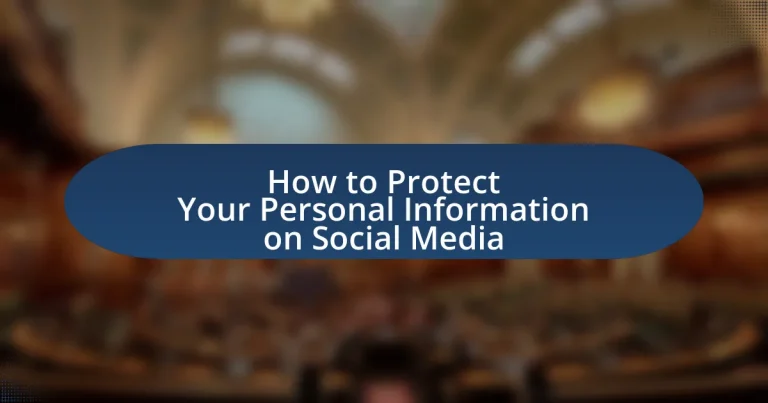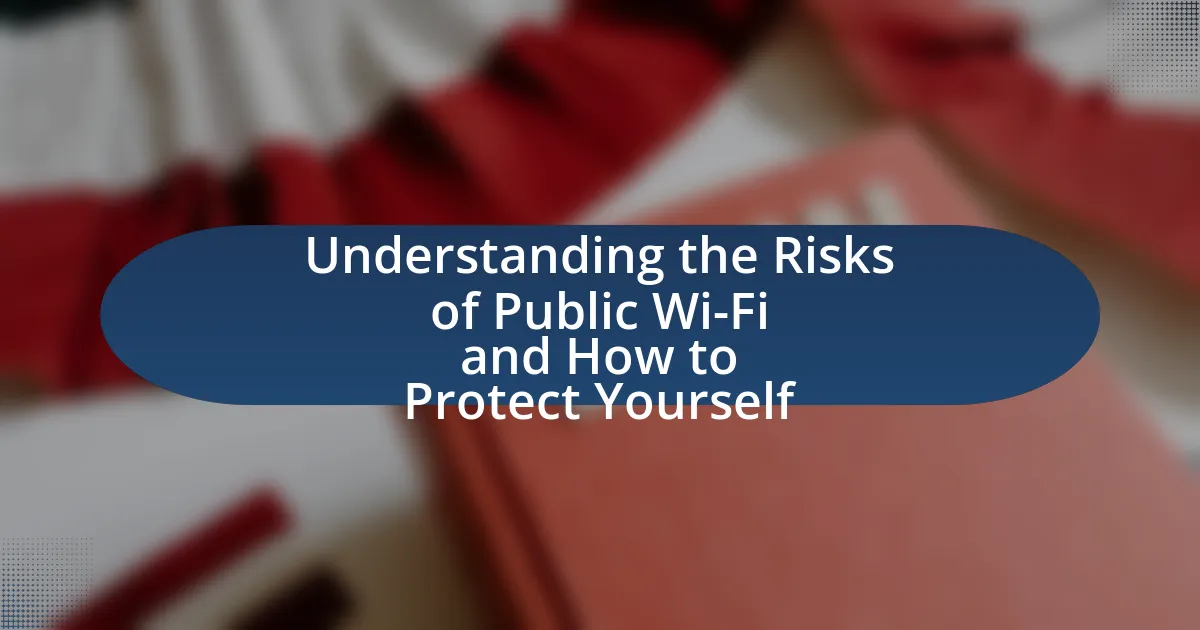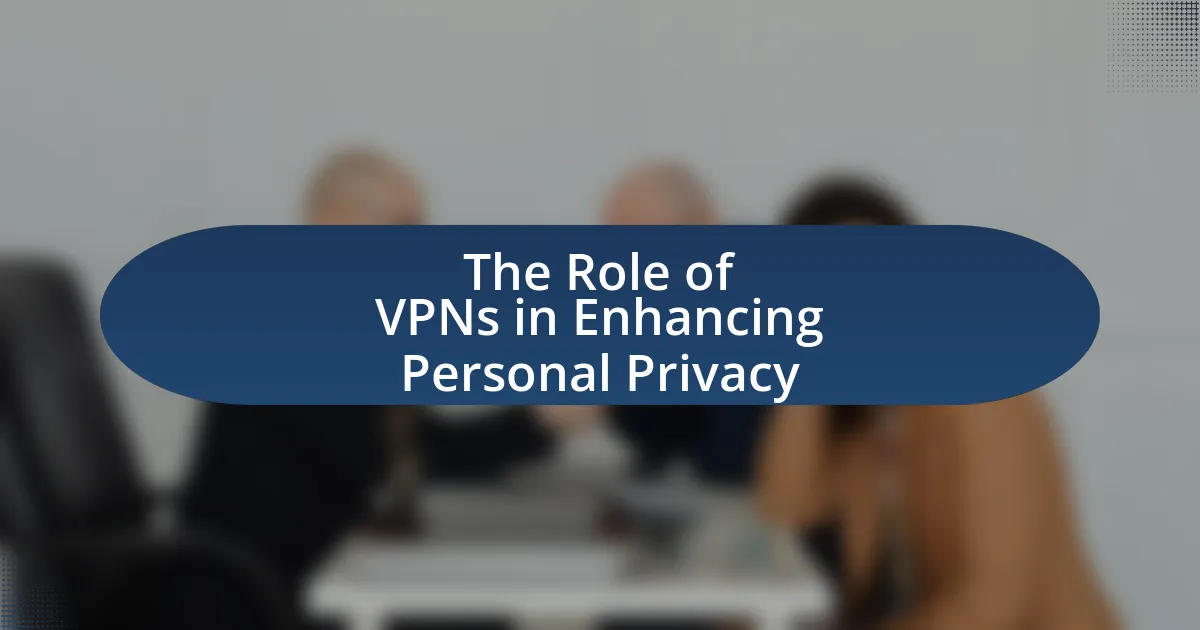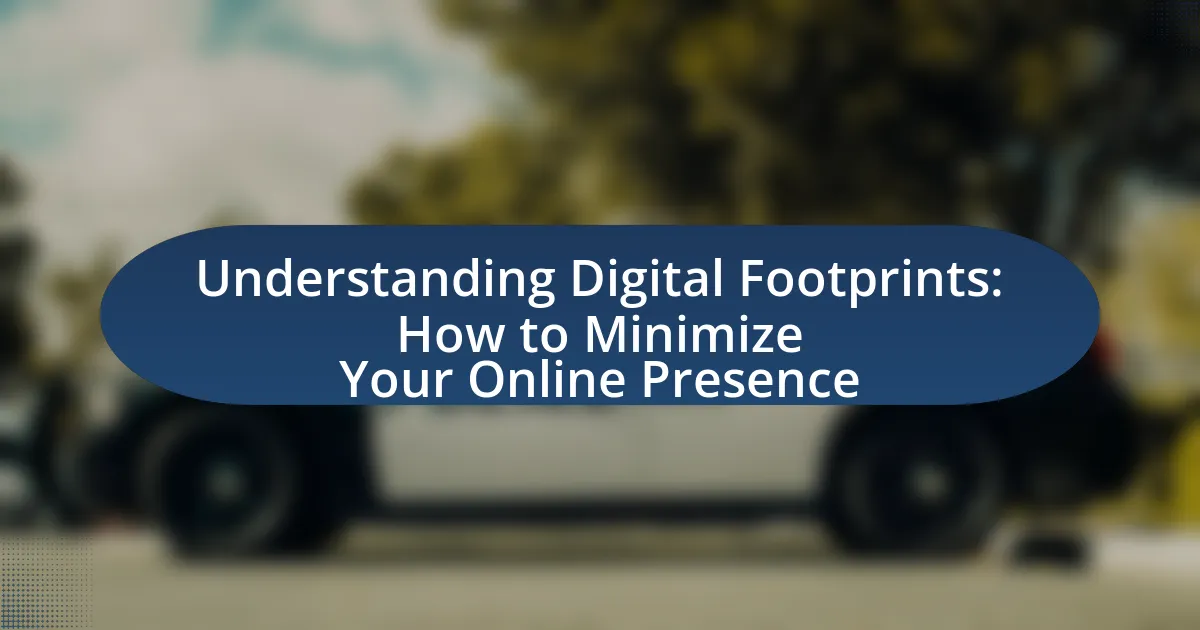The article focuses on the critical importance of protecting personal information on social media to prevent identity theft, cyberbullying, and unauthorized access to sensitive data. It highlights the vulnerabilities associated with inadequate privacy settings and the types of personal information commonly shared, such as names, birthdates, and locations. The potential consequences of not safeguarding this information include identity theft, financial loss, and reputational damage. The article also provides practical steps for enhancing privacy settings across major platforms, utilizing strong passwords, enabling two-factor authentication, and being mindful of the information shared online. Additionally, it discusses tools and resources for monitoring online presence and emphasizes the need for regular reviews of social media accounts to maintain security.

What is the importance of protecting personal information on social media?
Protecting personal information on social media is crucial to prevent identity theft, cyberbullying, and unauthorized access to sensitive data. Social media platforms often collect vast amounts of personal data, which can be exploited by malicious actors. According to a 2020 report by the Identity Theft Resource Center, there were over 1,100 data breaches in the U.S., exposing millions of personal records. This highlights the need for individuals to safeguard their information to mitigate risks associated with privacy violations and financial loss.
Why is personal information vulnerable on social media platforms?
Personal information is vulnerable on social media platforms due to inadequate privacy settings and data-sharing practices. Many users do not adjust their privacy settings, leaving their profiles open to public view, which allows unauthorized access to personal data. Additionally, social media companies often collect and share user data with third parties for advertising purposes, increasing the risk of data breaches. According to a 2021 report by the Identity Theft Resource Center, over 1,600 data breaches were reported, exposing millions of personal records, highlighting the systemic vulnerabilities inherent in social media platforms.
What types of personal information are commonly shared on social media?
Common types of personal information shared on social media include names, birthdates, locations, contact information, and photos. Users often disclose their interests, relationship statuses, and employment details as well. According to a 2021 survey by the Pew Research Center, 69% of adults reported sharing their location on social media, while 54% shared their birthdate. This data highlights the prevalence of personal information sharing on these platforms, which can pose privacy risks.
How can sharing personal information lead to privacy breaches?
Sharing personal information can lead to privacy breaches by exposing individuals to unauthorized access and misuse of their data. When users disclose sensitive details such as their location, contact information, or financial data on social media platforms, they create opportunities for cybercriminals to exploit this information. For instance, a study by the Identity Theft Resource Center found that 1 in 4 data breaches in 2020 involved personal information being shared publicly, which significantly increases the risk of identity theft and fraud. Additionally, oversharing can enable social engineering attacks, where attackers manipulate individuals into revealing more confidential information.
What are the potential consequences of not protecting personal information?
Not protecting personal information can lead to identity theft, financial loss, and reputational damage. Identity theft occurs when personal data is accessed and used without consent, resulting in unauthorized transactions and credit issues. According to the Federal Trade Commission, in 2020, there were over 1.4 million reports of identity theft in the United States, highlighting the prevalence of this issue. Financial loss can arise from fraudulent activities, with victims often facing significant expenses to recover their identities and finances. Additionally, reputational damage can occur when sensitive information is leaked, affecting personal and professional relationships. These consequences underscore the critical importance of safeguarding personal information, especially on social media platforms where data can be easily shared and exploited.
How can identity theft occur through social media?
Identity theft can occur through social media when individuals share personal information that can be exploited by malicious actors. For example, posting details such as full names, addresses, phone numbers, or even vacation plans can provide thieves with the necessary data to impersonate someone or access sensitive accounts. According to a study by the Federal Trade Commission, 25% of identity theft cases in the U.S. involve the use of social media to gather personal information. This highlights the risk associated with oversharing and the importance of privacy settings to limit access to personal data.
What impact can privacy breaches have on personal and professional life?
Privacy breaches can severely disrupt both personal and professional life by exposing sensitive information, leading to identity theft, financial loss, and reputational damage. For individuals, the unauthorized disclosure of personal data can result in emotional distress, loss of trust in online platforms, and potential harassment. In professional settings, breaches can compromise confidential business information, damage client relationships, and lead to legal repercussions, as evidenced by the 2020 Verizon Data Breach Investigations Report, which found that 86% of breaches were financially motivated. This highlights the critical need for robust privacy protections on social media to mitigate these risks.
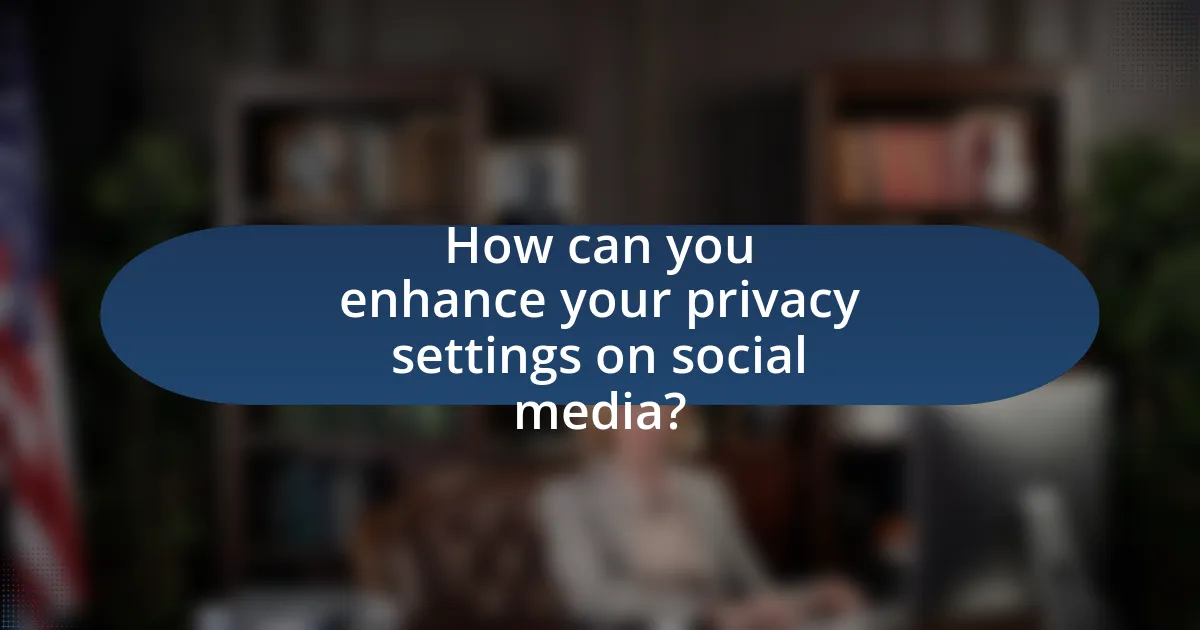
How can you enhance your privacy settings on social media?
To enhance your privacy settings on social media, adjust your account settings to limit who can see your posts and personal information. Most platforms allow users to customize privacy settings, such as making profiles private, restricting friend requests, and controlling who can comment on posts. For example, Facebook enables users to select “Friends” or “Only Me” for post visibility, while Instagram offers similar options under “Privacy” settings. Regularly reviewing and updating these settings is essential, as social media platforms frequently change their privacy policies and features.
What steps should you take to adjust privacy settings on major platforms?
To adjust privacy settings on major platforms, first, access the account settings or privacy section of the platform you are using. For example, on Facebook, click on the downward arrow in the top right corner, select “Settings & Privacy,” then “Settings,” and navigate to “Privacy” to customize who can see your posts and personal information. On Instagram, go to your profile, tap the three lines in the top right, select “Settings,” then “Privacy,” where you can switch your account to private and manage story settings. On Twitter, click on “More” in the sidebar, select “Settings and privacy,” then “Privacy and safety,” allowing you to control who can see your tweets and direct messages. These steps are consistent across platforms, ensuring users can effectively manage their privacy settings to protect personal information.
How do you change privacy settings on Facebook?
To change privacy settings on Facebook, navigate to the top right corner of the Facebook homepage and click on the downward-facing arrow. From the dropdown menu, select “Settings & Privacy,” then click on “Settings.” In the left sidebar, choose “Privacy” to access various privacy options, including who can see your posts, friend requests, and profile information. Adjust these settings according to your preferences to enhance your privacy. This process is validated by Facebook’s official help documentation, which outlines the steps for managing privacy settings effectively.
What are the privacy options available on Instagram?
Instagram offers several privacy options to help users protect their personal information. Users can set their accounts to private, which restricts access to their posts and stories to approved followers only. Additionally, users can control who can comment on their posts, limit interactions through the “Restrict” feature, and block specific users entirely. Instagram also allows users to manage their data visibility by hiding their activity status and controlling who can send them direct messages. Furthermore, users can review and adjust their ad preferences to limit targeted advertising based on their activity. These features collectively enhance user privacy and control over personal information on the platform.
What features should you utilize to protect your information?
To protect your information on social media, utilize privacy settings, two-factor authentication, and content control features. Privacy settings allow you to restrict who can view your profile and posts, ensuring that only trusted individuals have access to your information. Two-factor authentication adds an extra layer of security by requiring a second form of verification, significantly reducing the risk of unauthorized access. Content control features enable you to manage who can comment on or share your posts, further safeguarding your personal data. According to a 2021 study by the Pew Research Center, 70% of social media users have adjusted their privacy settings to enhance their security, demonstrating the effectiveness of these features in protecting personal information.
How can two-factor authentication enhance your account security?
Two-factor authentication enhances account security by requiring a second form of verification in addition to a password. This additional layer significantly reduces the risk of unauthorized access, as even if a password is compromised, the account remains secure without the second factor, which is typically a code sent to a mobile device or generated by an authentication app. According to a study by Google, enabling two-factor authentication can block 100% of automated bots and 96% of phishing attacks, demonstrating its effectiveness in protecting personal information on social media platforms.
What role do strong passwords play in protecting your social media accounts?
Strong passwords are essential for protecting social media accounts by significantly reducing the risk of unauthorized access. A strong password typically includes a combination of uppercase and lowercase letters, numbers, and special characters, making it difficult for attackers to guess or crack through brute force methods. According to a study by the Cybersecurity & Infrastructure Security Agency, 81% of data breaches are linked to weak or stolen passwords, highlighting the critical role that robust password practices play in safeguarding personal information on social media platforms.
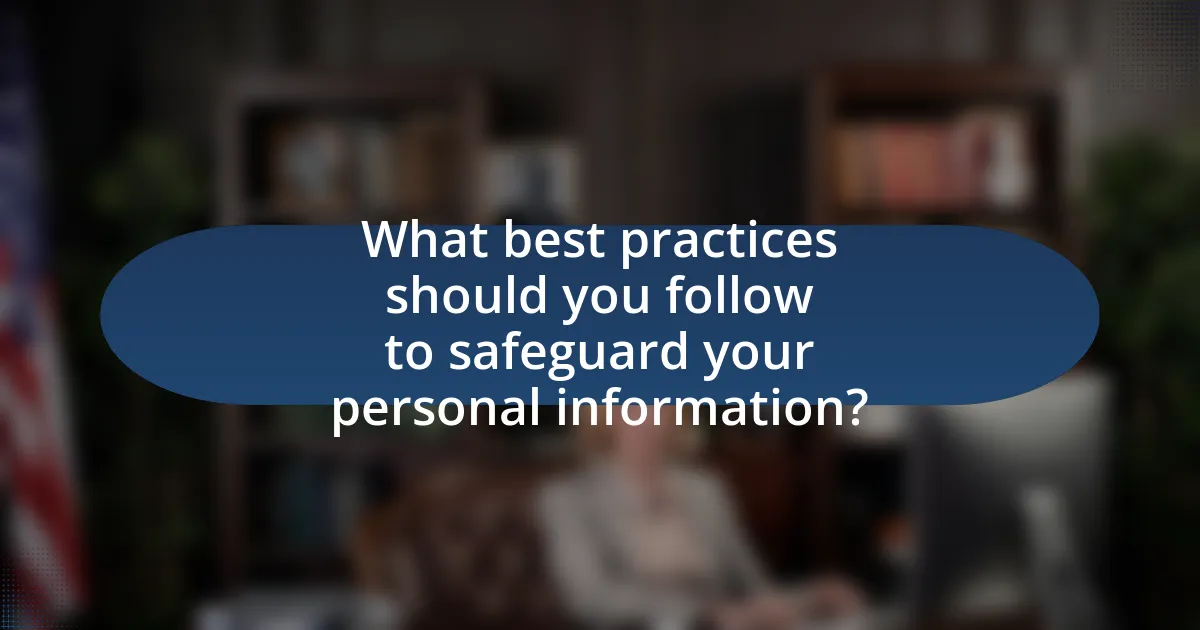
What best practices should you follow to safeguard your personal information?
To safeguard your personal information, implement strong passwords, enable two-factor authentication, and be cautious about sharing personal details online. Strong passwords should be complex, combining letters, numbers, and symbols, and should be changed regularly; studies show that 81% of data breaches are due to weak passwords. Two-factor authentication adds an extra layer of security, making unauthorized access significantly more difficult. Additionally, limit the amount of personal information shared on social media platforms, as oversharing can lead to identity theft; according to the Federal Trade Commission, identity theft affected 1.4 million consumers in 2020 alone. Regularly review privacy settings on social media accounts to control who can see your information, and be wary of friend requests from unknown individuals.
How can you be mindful of what you share online?
To be mindful of what you share online, evaluate the potential impact of your content before posting. This involves considering the privacy settings of your social media accounts, understanding the audience that will see your posts, and recognizing that once shared, information can be difficult to retract. Research indicates that 70% of employers use social media to screen candidates, highlighting the importance of maintaining a professional online presence. Additionally, a study by the Pew Research Center found that 64% of Americans have experienced some form of online harassment, underscoring the risks associated with oversharing personal information.
What guidelines should you follow when posting photos or updates?
When posting photos or updates, prioritize privacy by adjusting your account settings to limit visibility to trusted contacts only. This ensures that only selected individuals can view your content, reducing the risk of unauthorized access. Additionally, avoid sharing sensitive information such as your location, personal identification, or financial details in your posts, as these can be exploited by malicious actors. Research indicates that 70% of social media users have experienced privacy breaches due to oversharing (Pew Research Center, 2021). Therefore, always think critically about the content you share and consider its potential impact on your personal security.
How can you avoid oversharing personal details in your profile?
To avoid oversharing personal details in your profile, limit the information you provide to only what is necessary for your intended audience. This includes avoiding sensitive data such as your home address, phone number, and financial information. Research indicates that 70% of social media users have experienced privacy breaches due to oversharing, highlighting the importance of being cautious. Additionally, regularly reviewing and adjusting your privacy settings can help control who sees your information, further minimizing the risk of oversharing.
What tools and resources can help you monitor your online presence?
Tools and resources that can help monitor your online presence include Google Alerts, social media monitoring tools like Hootsuite and Brand24, and reputation management services such as Reputation.com. Google Alerts allows users to receive notifications when their name or specified keywords appear online, providing real-time updates. Hootsuite and Brand24 enable users to track mentions across various social media platforms, helping to gauge public perception and engagement. Reputation.com offers comprehensive monitoring and management of online reviews and mentions, ensuring individuals can respond promptly to any negative content. These tools collectively provide a robust framework for individuals to stay informed about their online reputation and protect their personal information on social media.
How can you use privacy-focused tools to track your information online?
You can use privacy-focused tools such as VPNs, encrypted browsers, and privacy-centric search engines to track your information online. These tools help you monitor data collection practices by providing insights into which websites are tracking your activity and how your data is being used. For instance, a VPN encrypts your internet connection, making it difficult for third parties to track your online behavior. Encrypted browsers like Brave block trackers and ads, allowing you to see which sites attempt to collect your data. Privacy-centric search engines like DuckDuckGo do not track your search history, providing a clearer view of your online footprint. These tools collectively enhance your ability to understand and manage your personal information in the digital landscape.
What are the benefits of regularly reviewing your social media accounts?
Regularly reviewing your social media accounts enhances your online security and privacy. This practice allows individuals to identify and remove outdated or unnecessary personal information, reducing the risk of identity theft. According to a 2021 study by the Identity Theft Resource Center, 1 in 15 Americans experienced identity theft, highlighting the importance of proactive measures. Additionally, reviewing accounts helps users manage privacy settings, ensuring that only trusted individuals can access their information. By regularly checking friend lists and followers, users can also eliminate connections that may pose a security risk, further safeguarding their personal data.
What are some practical tips for protecting your personal information on social media?
To protect your personal information on social media, use strong, unique passwords for each account and enable two-factor authentication. Strong passwords reduce the risk of unauthorized access, while two-factor authentication adds an extra layer of security by requiring a second form of verification. Additionally, regularly review and adjust your privacy settings to limit who can see your posts and personal information. According to a 2021 study by the Pew Research Center, 70% of social media users have adjusted their privacy settings to control their information visibility. Lastly, be cautious about sharing personal details, such as your location or contact information, as oversharing can lead to identity theft or harassment.
